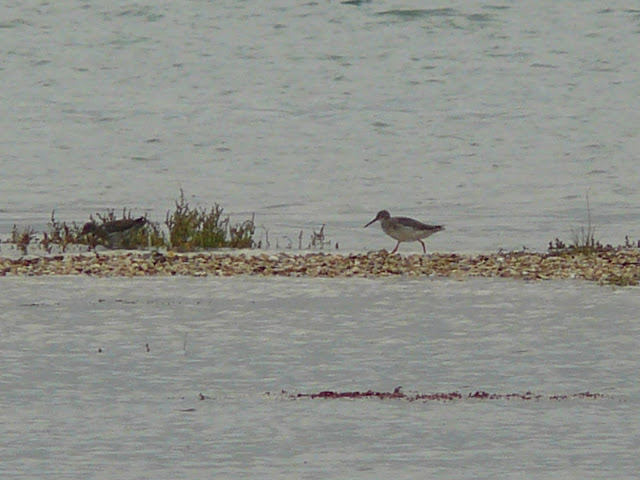Please read section 1, (the previous blog entry below) before this section 2.
From the beach we set off against the rising tide, still hoping for dry feet.
It didn't look too good. But the sea was warm; there was no sign of ice.
In for a penny, in for a pound. Once your boots are full of sea water, who cares any more.
"Keep to the dry bits Gloria!" advised Richard.
At Church Norton we reached dry land and set up the telescope to see the birds on the islands.
The new display boards are attractively bordered in carved wood and highly informative. Well done WSCC. Click on the picture to expand.
On the middle distance shingle bank were Redshanks.
Whilst out in the far distance were cormorants at one end of the island,
and black-backed gulls at the other end. Bognor town is the backdrop to this shot.
I had hoped to have lunch in the bird-hide at Church Norton, but all access paths were in deep water.
We had our picnic in the graveyard, where Richard found a pair of dry socks in his rucksack, and in a quite extraordinary act of chivalry and gallantry, offered them to Liz; thus saving her from potentially debilitating foot-rot by the end of the day.
After lunch we continued around the harbour and spotted this grebe.
The path was really soft under foot and because our boots were full of (by now warmed) seawater our feet were also getting softened beautifully; except Liz, who had dry socks.
The farmland on the left is 2 meters or more below the sea level on the right. You could have been in The Netherlands. Look how sad the group is to be on terra firma after leaving the sea-bathing section of the walk. (There is more to come in section 3.)
Mr and Mrs Mallard.
Little Egrets in flight.
Coot.
There was a large flock of small birds; perhaps a hundred or more.
They were difficult to identify in the field.
As they flew away, I got a shot of the birds in flight. Click to expand.
They are juvenile Goldfinches, which have yet to develop their red heads. This flock of 100 or more birds was impressive.
We were now approaching Ferry pool, where I shall start Section 3. of this walk.
Here is a trailer.... an Avocet.
For illustrated talks on natural history and history see www.peterlovetttalks.co.uk
For illustrated talks on natural history and history click here for www.peterlovetttalks.co.uk
Subscribe to:
Post Comments (Atom)
Blog Archive
-
▼
2010
(88)
-
▼
September
(10)
- Amazon Lilly
- Ladybird, Scymus frontalis
- Fungi in a Sussex wood
- The Boer War, remembered
- Pagham Harbour walk; Section 3:The Northern Harbou...
- Pagham Harbour walk; Section 2:The southern Harbour.
- Pagham Harbour walk; Section 1:Turnstones and gull...
- Oare Marshes, near Faversham, Kent.
- Autumn Lady's-tresses orchids
- Hornets
-
▼
September
(10)




















No comments:
Post a Comment